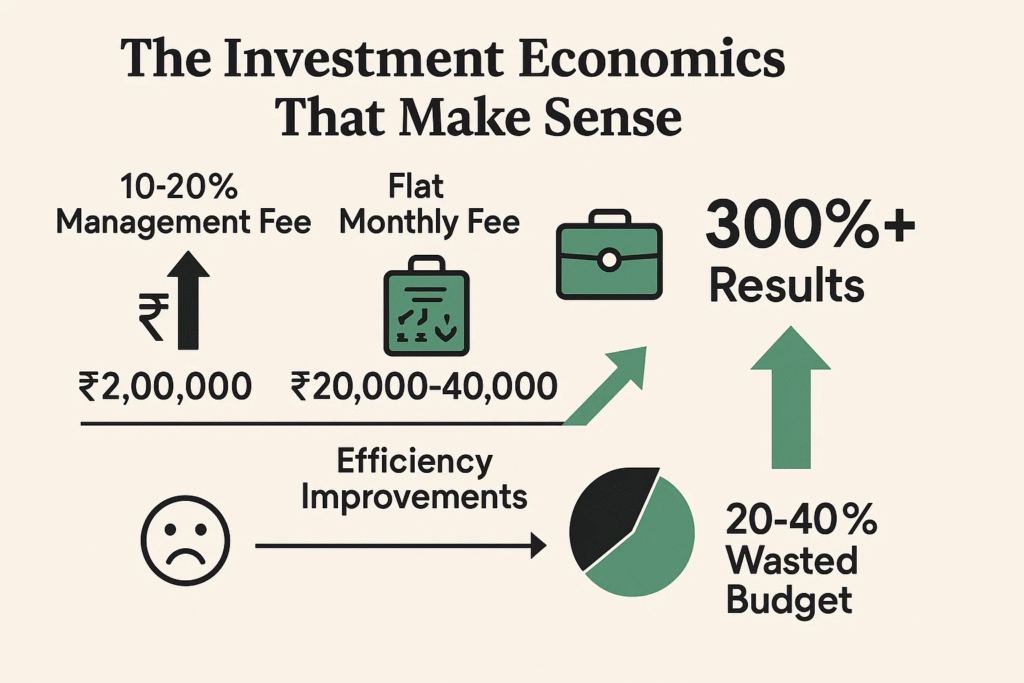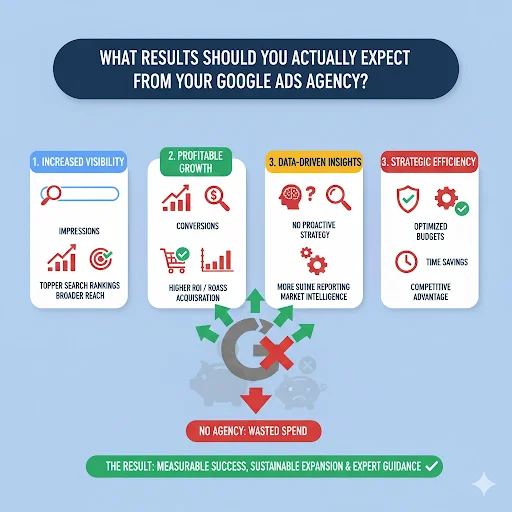A retail business owner showed me their agency’s monthly report last week, beaming with pride about 15,000 impressions and 450 clicks. When I asked about conversions and revenue, she went quiet. She had no idea whether those clicks generated sales or just drained her ₹85,000 monthly budget. Her agency had been reporting vanity metrics for six months while she celebrated numbers that meant absolutely nothing for her bottom line of Google Ads agency.
This happens constantly. Businesses hire agencies, get impressive-looking reports full of graphs and percentages, and assume everything’s working great. Meanwhile, they have no clue whether advertising is actually profitable or slowly bleeding them dry because nobody’s tracking what matters.
The Metrics That Actually Matter
Here’s what most businesses don’t understand about agency performance: the numbers in reports should directly connect to business outcomes, not just advertising activity. Impressions and clicks might look impressive, but they’re worthless unless they drive conversions, revenue, and profit Google Ads agency. Professional agencies focus relentlessly on metrics that impact your bank account, not just activity that makes reports look busy.
Conversion rate reveals how effectively traffic turns into valuable actions—purchases, leads, phone calls, form submissions. Industry benchmarks show average conversion rates around 4.6-7.5% depending on sector, though this varies enormously by business type. Ecommerce might convert at 2-4%, while service businesses with high-intent keywords hit 10-15%. The key isn’t matching some arbitrary benchmark—it’s knowing your conversion rate, tracking trends, and continuously improving through testing.
Cost per acquisition determines whether campaigns are financially sustainable. If you’re paying ₹3,000 to acquire customers worth ₹2,500, advertising loses money regardless of how many conversions happen. Professional agencies calculate target CPA based on your customer lifetime value, profit margins, and business economics. They optimize toward profitable acquisition costs, not just conversion volume.
Return on ad spend connects advertising directly to revenue. This metric shows how much revenue your ads generate for every rupee invested. Benchmarks suggest ROAS of 2:1 (₹2 revenue per ₹1 spent) represents break-even for many businesses after accounting for product costs and overhead. Strong campaigns achieve 4:1 or higher, meaning ₹4 in revenue for every ₹1 in ad spend.
Quality Score affects both costs and ad position, making it critical for campaign efficiency. Scores of 7-10 indicate well-optimized campaigns paying reasonable rates for good placement. Scores below 5 mean you’re paying premium prices for poor positions—a disaster that professional management prevents through proper optimization.
Click-through rate measures ad relevance and appeal. Industry averages run 3-7% for search campaigns depending on sector. Low CTR suggests ads aren’t compelling or keywords don’t match search intent well. High CTR indicates strong relevance, which improves Quality Score and reduces costs for Google Ads agency.
The Timeline Reality Nobody Explains
This is where understanding realistic expectations becomes critical when working with a google ads marketing agency. Campaigns don’t deliver optimal results immediately—they need time to gather data, optimize delivery, and reach peak performance.
The first 1-2 weeks represent the learning phase where Google’s algorithm collects data about your audience, keywords, and conversion patterns. Performance during this period is often volatile and not representative of long-term results. Professional agencies explain this upfront, preventing panic when initial metrics look mediocre.
Weeks 3-4 show early optimization as the algorithm begins applying learnings to improve delivery. Costs typically decrease and conversion rates improve compared to week one, though full potential hasn’t been reached yet. This is where agencies refine targeting, adjust bids, add negative keywords, and optimize based on initial data.
Weeks 5-8 are when profitability typically emerges as campaigns hit their optimization stride. Research shows new campaigns often operate at negative ROI during the first 2-3 weeks, sometimes losing 20% or more as the platform learns. By weeks 6-8, ROI usually turns positive and continues improving as the algorithm accumulates more conversion data.
Month 3-6 represents mature campaign performance where results stabilize and scale becomes possible. At this stage, agencies have comprehensive data revealing what works, which audiences convert best, what messaging resonates, and where budget should focus. Strategic expansion happens from this solid foundation rather than premature scaling that destroys barely-stable campaigns.
The patience required frustrates businesses wanting instant results, but this timeline reflects platform reality, not agency incompetence. Agencies that promise immediate results are either lying or planning to show you vanity metrics while actual profitability remains elusive to Google Ads agency.
The Transparency That Builds Trust
Professional google ads agency partnerships provide complete transparency in reporting, account access, and communication. You should have full administrator access to your own Google Ads account—always. Agencies manage campaigns with delegated access that you grant and can revoke if the relationship ends. Any agency refusing complete account access is hiding something or setting you up for hostage situations if you try to leave.
Monthly reports should focus on business outcomes rather than vanity metrics. Impressions and clicks matter only as leading indicators toward conversions and revenue. Professional reporting shows the complete funnel—traffic generated, conversion rates achieved, cost per acquisition delivered, and total revenue or leads produced. Everything connects to business impact rather than just advertising activity.
The change history in your account reveals whether agencies are actually doing the work they’re charging for. Google Ads tracks every modification made to campaigns—keyword additions, bid adjustments, ad copy changes, budget modifications, everything. When change logs show weeks with minimal activity, you’re paying for management that isn’t happening. Professional accounts show continuous optimization through regular adjustments based on performance data.
Communication frequency and quality separate professional agencies from mediocre ones. You should receive detailed monthly reports, scheduled check-in calls discussing performance and strategy, and prompt responses to questions between meetings. Agencies taking days responding to simple questions or missing scheduled calls predict future relationship problems.
Strategic recommendations demonstrate agencies are thinking proactively rather than just maintaining existing campaigns. Professional management continuously proposes tests of new features, expansion into adjacent keywords or audiences, and strategic pivots based on competitive intelligence or market shifts. Agencies that just run campaigns on autopilot without suggesting improvements have gotten complacent.
The Investment Economics That Make Sense

Understanding agency pricing helps evaluate whether the investment delivers positive returns. Management fees typically run 10-20% of monthly ad spend for percentage-based pricing. On ₹2 lakhs monthly ad spend, that’s ₹20,000-40,000 in management fees. Flat monthly fees range from ₹20,000-₹1.5 lakhs+ depending on account complexity and service scope.
The value calculation should account for efficiency improvements, not just management costs. If professional management eliminates 25% budget waste typical of DIY efforts, that saves ₹50,000 monthly on ₹2 lakh spend—more than covering the ₹30,000 management fee. If Quality Score optimization reduces cost per click 35%, conversion rate improvements double traffic value, and better targeting focuses spending on high-intent audiences, results might improve 300% from identical budgets.
The alternative is continuing to waste 20-40% of advertising budgets through inefficiencies that proper management prevents. Smart businesses recognize that agency fees represent investments generating returns through improved performance, not just expenses reducing net profit.
Cross-channel expertise extends value beyond just Google Ads platform management. Professional agencies coordinate search campaigns with display remarketing, YouTube awareness building, and social media nurturing across platforms like Facebook advertising. These integrated strategies create multiple touchpoints reaching prospects throughout buying journeys without duplicating spend.
The expertise gap between professional management and DIY attempts typically generates 3-5x performance differences from identical spending. Agencies recognize optimization opportunities instantly through experience managing hundreds of campaigns. They implement proven frameworks rather than guessing through expensive trial-and-error. They stay current with constant platform changes, testing new features immediately rather than hearing about updates months later.
The Partnership That Transforms Advertising Investment
Campaign success requires realistic expectations about metrics that matter, timelines for optimization, transparency in reporting and access, and fair economics where management fees generate returns through improved results. Professional agency relationships deliver all these elements through expertise businesses can’t replicate internally without years of focused development.
The vetting process should evaluate whether agencies focus on business outcomes versus vanity metrics, explain realistic timelines honestly rather than promising instant results, provide complete account access and transparent reporting, and charge fees justified by the value they deliver. These criteria separate professional partnerships from relationships that waste money while delivering mediocre results hidden behind confusing reports.
The alternative is celebrating impressive-looking numbers that mean nothing for your business while budgets evaporate without generating actual revenue or profit. Smart businesses demand accountability around metrics that impact their bottom line, realistic expectations about optimization timelines, and transparent partnerships where agencies prove value through measurable business outcomes.
Working with agencies possessing expertise, processes, and values aligned with your growth goals transforms advertising from frustrating expense into predictable revenue driver. The businesses that succeed recognize this partnership requires choosing carefully, setting clear expectations, monitoring performance against meaningful metrics, and holding agencies accountable for results that actually matter.
Find your next favorite read—Buzz BLOG has something special just for you!

